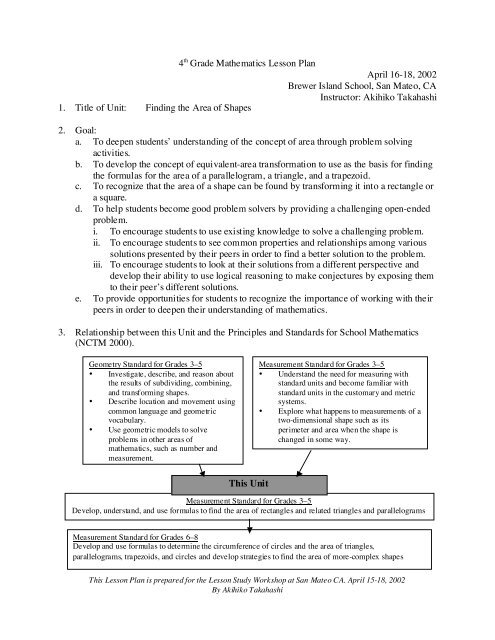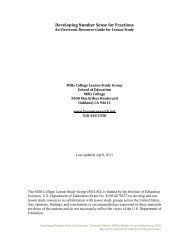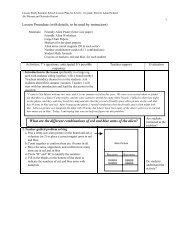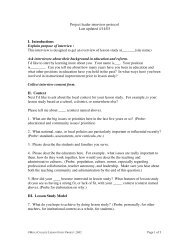4th Grade mathematics Lesson Plan - Lesson Study Group at Mills ...
4th Grade mathematics Lesson Plan - Lesson Study Group at Mills ...
4th Grade mathematics Lesson Plan - Lesson Study Group at Mills ...
You also want an ePaper? Increase the reach of your titles
YUMPU automatically turns print PDFs into web optimized ePapers that Google loves.
4 th <strong>Grade</strong> M<strong>at</strong>hem<strong>at</strong>ics <strong>Lesson</strong> <strong>Plan</strong><br />
April 16-18, 2002<br />
Brewer Island School, San M<strong>at</strong>eo, CA<br />
Instructor: Akihiko Takahashi<br />
1. Title of Unit: Finding the Area of Shapes<br />
2. Goal:<br />
a. To deepen students’ understanding of the concept of area through problem solving<br />
activities.<br />
b. To develop the concept of equivalent-area transform<strong>at</strong>ion to use as the basis for finding<br />
the formulas for the area of a parallelogram, a triangle, and a trapezoid.<br />
c. To recognize th<strong>at</strong> the area of a shape can be found by transforming it into a rectangle or<br />
a square.<br />
d. To help students become good problem solvers by providing a challenging open-ended<br />
problem.<br />
i. To encourage students to use existing knowledge to solve a challenging problem.<br />
ii. To encourage students to see common properties and rel<strong>at</strong>ionships among various<br />
solutions presented by their peers in order to find a better solution to the problem.<br />
iii. To encourage students to look <strong>at</strong> their solutions from a different perspective and<br />
develop their ability to use logical reasoning to make conjectures by exposing them<br />
to their peer’s different solutions.<br />
e. To provide opportunities for students to recognize the importance of working with their<br />
peers in order to deepen their understanding of <strong>m<strong>at</strong>hem<strong>at</strong>ics</strong>.<br />
3. Rel<strong>at</strong>ionship between this Unit and the Principles and Standards for School M<strong>at</strong>hem<strong>at</strong>ics<br />
(NCTM 2000).<br />
Geometry Standard for <strong>Grade</strong>s 3–5<br />
• Investig<strong>at</strong>e, describe, and reason about<br />
the results of subdividing, combining,<br />
and transforming shapes.<br />
• Describe loc<strong>at</strong>ion and movement using<br />
common language and geometric<br />
vocabulary.<br />
• Use geometric models to solve<br />
problems in other areas of<br />
<strong>m<strong>at</strong>hem<strong>at</strong>ics</strong>, such as number and<br />
measurement.<br />
Measurement Standard for <strong>Grade</strong>s 3–5<br />
• Understand the need for measuring with<br />
standard units and become familiar with<br />
standard units in the customary and metric<br />
systems.<br />
• Explore wh<strong>at</strong> happens to measurements of a<br />
two-dimensional shape such as its<br />
perimeter and area when the shape is<br />
changed in some way.<br />
This Unit<br />
Measurement Standard for <strong>Grade</strong>s 3–5<br />
Develop, understand, and use formulas to find the area of rectangles and rel<strong>at</strong>ed triangles and parallelograms<br />
Measurement Standard for <strong>Grade</strong>s 6–8<br />
Develop and use formulas to determine the circumference of circles and the area of triangles,<br />
parallelograms, trapezoids, and circles and develop str<strong>at</strong>egies to find the area of more-complex shapes<br />
This <strong>Lesson</strong> <strong>Plan</strong> is prepared for the <strong>Lesson</strong> <strong>Study</strong> Workshop <strong>at</strong> San M<strong>at</strong>eo CA. April 15-18, 2002<br />
By Akihiko Takahashi
4. Instructional <strong>Plan</strong><br />
Shapes and Area: Three lessons total<br />
i. How to find the area of a shape using previously learned knowledge (1)<br />
ii. How to find the area of a shape using previously learned knowledge (2)<br />
iii. Making shapes th<strong>at</strong> contain an area of eight square units on the geoboard<br />
5. Instruction of the <strong>Lesson</strong>s<br />
A series of lessons consisting of three periods of hands-on problem solving activities was<br />
planned to help students extend existing knowledge and develop a found<strong>at</strong>ion for finding the<br />
formulas for the area of a parallelogram, a triangle, and a trapezoid.<br />
These lessons were based on the idea of student-centered instruction which the NCTM<br />
Standards (2001) supports. This idea is expressed in the objective: “To provide students with an<br />
opportunity to develop a formula for the area of parallelogram meaningfully through<br />
investig<strong>at</strong>ion.” According to the Standards, “Students can develop formulas for the area of a<br />
parallelogram and a triangle by using wh<strong>at</strong> they have learned previously.” This prior knowledge<br />
includes the formula to find the area of a rectangle and the concepts of decomposing a shape and<br />
rearranging its components to make more familiar shapes without changing the area of the<br />
original shape. Although the Standards do not provide detailed inform<strong>at</strong>ion on how a teacher can<br />
help students to develop formulas for finding the area of parallelograms, triangles, and trapezoids<br />
meaningfully, it is important for students to have the opportunity to investig<strong>at</strong>e and experience<br />
how those formulas can be developed by incorpor<strong>at</strong>ing their previously learned knowledge.<br />
One way to help the students to develop these formulas through such investig<strong>at</strong>ion is to<br />
provide them with a series of problem solving lessons using manipul<strong>at</strong>ives to develop the<br />
concept of equivalent-area transform<strong>at</strong>ion. Equivalent-area transform<strong>at</strong>ion is a key concept<br />
necessary to develop the formulas for finding the area of parallelograms, triangles, and<br />
trapezoids. This idea is developed by incorpor<strong>at</strong>ing students’ prior knowledge, such as the<br />
formula for finding the area of a rectangle and a square. Therefore, it might be a good idea to<br />
provide lessons designed to help students develop the concept of equivalent-area transform<strong>at</strong>ion<br />
prior to lessons designed to investig<strong>at</strong>e the formula for finding the area of parallelograms,<br />
triangles, and trapezoids specifically. In order to do so a series of open-ended problem solving<br />
activities were developed based on Japanese problem-solving teaching methods/activities th<strong>at</strong> are<br />
commonly used in Japan.<br />
The Geoboard was chosen as the main manipul<strong>at</strong>ive for this series of problem-solving<br />
activities because of the following reasons:<br />
• It is a manipul<strong>at</strong>ive th<strong>at</strong> helps students to understand the rel<strong>at</strong>ionship among various<br />
shapes and their areas.<br />
• It has been one of the most commonly used manipul<strong>at</strong>ives in <strong>m<strong>at</strong>hem<strong>at</strong>ics</strong> educ<strong>at</strong>ion<br />
and various reform curricula have included it as a tool to provide students with<br />
opportunity to explore m<strong>at</strong>hem<strong>at</strong>ical ideas.<br />
This <strong>Lesson</strong> <strong>Plan</strong> is prepared for the <strong>Lesson</strong> <strong>Study</strong> Workshop <strong>at</strong> San M<strong>at</strong>eo CA. April 15-18, 2002<br />
By Akihiko Takahashi
6. <strong>Lesson</strong> Procedure<br />
(1) How to find the area of a shape by using the knowledge th<strong>at</strong> we have learned (1)<br />
Learning Activities<br />
Teacher’s Support<br />
Teacher’s Questions and Expected Students’ Reactions<br />
1. Introduction<br />
Let students make the<br />
Make this rectangle on your geoboard and find the area.<br />
rectangle on a geoboard<br />
by assuming the<br />
distance between two<br />
pegs is one inch.<br />
4cm<br />
Help students recall<br />
how to use a geoboard.<br />
Help students recall the<br />
5cm<br />
formula for finding the<br />
area of a rectangle,<br />
• Counting the number of unit squares on a geoboard<br />
• Using the formula for finding the area of rectangle,<br />
L ¥W .<br />
L ¥W , and ask<br />
students to explain wh<strong>at</strong><br />
this formula means.<br />
Points of<br />
Evalu<strong>at</strong>ion<br />
Do the students<br />
recall how to<br />
use a<br />
geoboard?<br />
Do the students<br />
recall the<br />
formula for<br />
finding the area<br />
of a rectangle<br />
as well as the<br />
idea behind the<br />
formula?<br />
2. Posing the Problem Let students make the<br />
†<br />
shape.<br />
†<br />
Give each student a<br />
Make the following shape on a geoboard and find the area.<br />
worksheet with a picture<br />
of the shape on a<br />
geoboard so th<strong>at</strong><br />
students can record their<br />
ideas about finding the<br />
area.<br />
Let students know th<strong>at</strong><br />
any ideas about finding<br />
the area based on their<br />
previous knowledge are<br />
acceptable.<br />
3. Individual Problem Solving<br />
a. Determine how to find the area of the shape by: Counting<br />
the number of small squares in the shape.<br />
Encourage students to<br />
find a couple of<br />
different ways to find<br />
the areas.<br />
Provide students with<br />
worksheets to keep their<br />
work for whole class<br />
discussion.<br />
Do students<br />
understand the<br />
problem?<br />
Can each<br />
student find <strong>at</strong><br />
least one way<br />
to find the<br />
area?<br />
Encourage students to<br />
recall wh<strong>at</strong> they learned<br />
in previous <strong>m<strong>at</strong>hem<strong>at</strong>ics</strong><br />
lessons.<br />
This <strong>Lesson</strong> <strong>Plan</strong> is prepared for the <strong>Lesson</strong> <strong>Study</strong> Workshop <strong>at</strong> San M<strong>at</strong>eo CA. April 15-18, 2002<br />
By Akihiko Takahashi
. Dividing or transforming this shape into the shapes th<strong>at</strong><br />
students already know how to find the area by using a<br />
formula.<br />
. 4x3 + 2x2=16 2x3 + 2x5=16 4x5 – 2x2=16<br />
3. Comparing and Discussing Students’ Solutions<br />
(1) Ask students to explain their solution methods to the class.<br />
(2) Facilit<strong>at</strong>e students’ discussion about their solutions in order to<br />
understand their ideas behind each solution.<br />
4. Find a str<strong>at</strong>egy to solve this kind of problem<br />
The area of the shape can be found by dividing the shape into<br />
rectangles and squares, or transforming it into a rectangle or a square.<br />
5. Summing up and Journal Writing<br />
(1) Using the writing on the blackboard, review wh<strong>at</strong> students<br />
learned through the lesson.<br />
(2) Ask Students to write a journal entry about wh<strong>at</strong> they learned<br />
through this lesson.<br />
Write each student’s<br />
solutions and on the<br />
blackboard in order to<br />
help students<br />
understand the<br />
discussion.<br />
Can each<br />
student<br />
understand th<strong>at</strong><br />
there are several<br />
ways to find the<br />
area?<br />
This <strong>Lesson</strong> <strong>Plan</strong> is prepared for the <strong>Lesson</strong> <strong>Study</strong> Workshop <strong>at</strong> San M<strong>at</strong>eo CA. April 15-18, 2002<br />
By Akihiko Takahashi
(2) How can we find the area of a parallelogram by using the knowledge th<strong>at</strong> we have learned?<br />
Learning Activities<br />
Teacher’s Questions and Expected Students’ Reactions<br />
Teacher’s Support Points of<br />
Evalu<strong>at</strong>ion<br />
1. Introduction to the Problem<br />
• Review the previous lesson.<br />
Ask some students to read their writing from the previous<br />
lesson.<br />
• Make the following shape on a geoboard<br />
2. Posing the Problem<br />
• Find the area of the shape on the geoboard by assuming th<strong>at</strong><br />
the distance between two pegs is one inch.<br />
By using selected student<br />
journal entries, which all<br />
the students wrote <strong>at</strong> the<br />
end of the previous class,<br />
help students to recall<br />
wh<strong>at</strong> they have learned.<br />
Provide each group of<br />
students with a picture of<br />
the shape on a geoboard,<br />
and let students make the<br />
shape on their geoboards<br />
by looking <strong>at</strong> the picture.<br />
Can students<br />
make the<br />
shape on<br />
their<br />
geoboard?<br />
Do students<br />
understand<br />
the problem?<br />
3. Individual Problem Solving<br />
Find the area of the parallelogram on a geoboard by:<br />
a. Dividing the shape into a triangle and the other part of the<br />
parallelogram and then cutting the triangle from the<br />
parallelogram and<br />
moving it to the other<br />
side of the shape to<br />
transform a<br />
4 in<br />
parallelogram into a<br />
rectangle without<br />
3 in<br />
changing its area.<br />
b. Calcul<strong>at</strong>ing the<br />
rectangle th<strong>at</strong> covers<br />
the parallelogram and<br />
subtracting the area of<br />
the two triangles.<br />
4 in<br />
4 in<br />
4. Discussing Students’ Solutions<br />
By examining several student’s solution methods, students are<br />
expected learn th<strong>at</strong> a key idea in finding the area of the parallelogram<br />
based on their previous knowledge is equivalent-area transform<strong>at</strong>ion.<br />
a. Ask students to explain their solution methods to the other<br />
students in the class.<br />
b. Facilit<strong>at</strong>e student discussion about their solutions, then lead<br />
students to realize th<strong>at</strong> a key idea in finding the area of the<br />
parallelogram is equivalent-area transform<strong>at</strong>ion.<br />
Encourage students to use<br />
the knowledge th<strong>at</strong> they<br />
learned previously to find<br />
the areas.<br />
Provide students with<br />
worksheets th<strong>at</strong> have a<br />
picture of the shape on a<br />
geoboard so they can<br />
record their work for the<br />
whole class discussion.<br />
Prepare enough<br />
worksheets so students are<br />
able to have as many<br />
worksheets as they want.<br />
Write each student’s<br />
solutions and ideas on the<br />
blackboard in order to<br />
help students understand<br />
the discussion.<br />
Can each pair<br />
of students<br />
find a way to<br />
find the<br />
areas?<br />
Can students<br />
visualize the<br />
concept?<br />
This <strong>Lesson</strong> <strong>Plan</strong> is prepared for the <strong>Lesson</strong> <strong>Study</strong> Workshop <strong>at</strong> San M<strong>at</strong>eo CA. April 15-18, 2002<br />
By Akihiko Takahashi
5. Exercises Ask students if their<br />
Find the area of the following parallelogram on a geoboard.<br />
solution methods can be<br />
used to find the area of<br />
another parallelogram on a<br />
geoboard.<br />
6. Summing up<br />
(1) Using the writing on the blackboard, review wh<strong>at</strong> students learned<br />
through the lesson.<br />
(2) Ask students to write a journal entry about wh<strong>at</strong> they learned<br />
through this lesson.<br />
Help students understand<br />
th<strong>at</strong> the area of this<br />
parallelogram is the same<br />
as the previous<br />
parallelogram.<br />
This <strong>Lesson</strong> <strong>Plan</strong> is prepared for the <strong>Lesson</strong> <strong>Study</strong> Workshop <strong>at</strong> San M<strong>at</strong>eo CA. April 15-18, 2002<br />
By Akihiko Takahashi
(3) Making shapes with an area of eight square units on the geoboard<br />
Learning Activities<br />
Teacher’s Support<br />
Teacher’s Questions and Expected Students’ Reactions<br />
1. Introduction to the Problem<br />
• Review the previous lesson.<br />
By using selected student journal<br />
Ask some students to read their writing from the entries, which all the students<br />
pervious lesson.<br />
wrote <strong>at</strong> the end of the previous<br />
class, help students to recall wh<strong>at</strong><br />
• Make the following shape on a geoboard<br />
they have learned.<br />
Points of<br />
Evalu<strong>at</strong>ion<br />
Can students<br />
make the shape<br />
on their<br />
geoboard?<br />
• Find the area of the shape on the geoboard.<br />
8 square inches<br />
2. Posing the Problem<br />
Make a four-sided shape with the same area as<br />
this shape<br />
2 Individual Problem Solving<br />
Anticip<strong>at</strong>ed student solutions: (See Appendix)<br />
Provide each group of students<br />
with a picture of the shape on a<br />
geoboard and let students make the<br />
shape on their geoboards by<br />
looking <strong>at</strong> the picture.<br />
Help students use ideas th<strong>at</strong> they<br />
learned previously such as<br />
equivalent-area transform<strong>at</strong>ion.<br />
To help all the students to<br />
understand this problem, give them<br />
several minutes to come up with<br />
some solutions. Then, examine<br />
some of those solutions as a whole<br />
class to see if any four-sided shape<br />
with an area of eight square units<br />
can be a solution. Therefore, there<br />
might be many different solutions.<br />
Provide each group of students<br />
several worksheets with a picture<br />
of the geoboard.<br />
Let students keep all the shapes<br />
th<strong>at</strong> they make on their geoboards<br />
so th<strong>at</strong> they can easily show them<br />
to the class during the whole class<br />
discussion.<br />
Do students<br />
recognize th<strong>at</strong><br />
the shape on<br />
the geoboard is<br />
the same kind<br />
of shape th<strong>at</strong><br />
they worked on<br />
previously?<br />
Do students<br />
understand the<br />
problem?<br />
Can students<br />
find <strong>at</strong> least one<br />
solution to the<br />
problem?<br />
This <strong>Lesson</strong> <strong>Plan</strong> is prepared for the <strong>Lesson</strong> <strong>Study</strong> Workshop <strong>at</strong> San M<strong>at</strong>eo CA. April 15-18, 2002<br />
By Akihiko Takahashi
3. Discussing Students’ Solutions<br />
(1) Ask students to explain why they think the shape has<br />
an area of eight square units.<br />
(2) After the students bring various shapes as their<br />
solutions, sort the shapes by using their previous<br />
knowledge. Their previous knowledge includes:<br />
Square: a four-sided figure with four right angles<br />
and four equal sides<br />
Rectangle: a four-sided figure with four right<br />
angles<br />
Parallelogram: a four-sided figure with two pairs<br />
of parallel sides<br />
Trapezoid: a four-sided figure with a pair of<br />
parallel sides<br />
Rhombus: a four-sided figure with four equal sides<br />
and two pairs of parallel sides<br />
5. Summing up<br />
(1) Using the writing on the blackboard, review wh<strong>at</strong><br />
students learned through the lesson.<br />
(2) Ask Students to write a journal entry about wh<strong>at</strong> they<br />
learned through this lesson.<br />
Appendix: Anticip<strong>at</strong>ed Students Solutions<br />
Ask students to bring and put their<br />
worksheets on the blackboard in<br />
order to help the other students<br />
understand wh<strong>at</strong> they have made<br />
and why the shape can be the<br />
solution to the problem.<br />
Help students realize th<strong>at</strong> many<br />
four-sided shapes with an area of<br />
eight square units can be made on<br />
the geoboard. These shapes include<br />
not only a rectangle and<br />
parallelograms but also a square,<br />
trapezoids, and rectangles with<br />
different orient<strong>at</strong>ions.<br />
Do students<br />
realize th<strong>at</strong><br />
several<br />
different<br />
quadril<strong>at</strong>erals<br />
with an area of<br />
eight square<br />
units can be<br />
made on the<br />
geoboard?<br />
This <strong>Lesson</strong> <strong>Plan</strong> is prepared for the <strong>Lesson</strong> <strong>Study</strong> Workshop <strong>at</strong> San M<strong>at</strong>eo CA. April 15-18, 2002<br />
By Akihiko Takahashi






